Leadership Qualities and Transformational Leadership in Healthcare
VerifiedAdded on 2022/09/17
|6
|1370
|23
Report
AI Summary
This report delves into the concept of leadership qualities, specifically examining transformational leadership within a healthcare context. The analysis centers on a fictional character, Dr. Smith, a physician at the Royal Melbourne Hospital in Australia, who embodies these qualities. Dr. Smith's leadership style is characterized by over-communication, transparency, accountability, and a commitment to empowering his team. The report highlights his ability to build trust, encourage innovation, and foster an ethical work environment. Dr. Smith effectively promotes a culture of collaboration and shared goals, emphasizing the importance of patient care and staff satisfaction. Through this case study, the report concludes that transformational leadership, as exemplified by Dr. Smith, is crucial for the success of healthcare organizations and the well-being of both staff and patients. The report references several academic sources to support its claims and analysis.
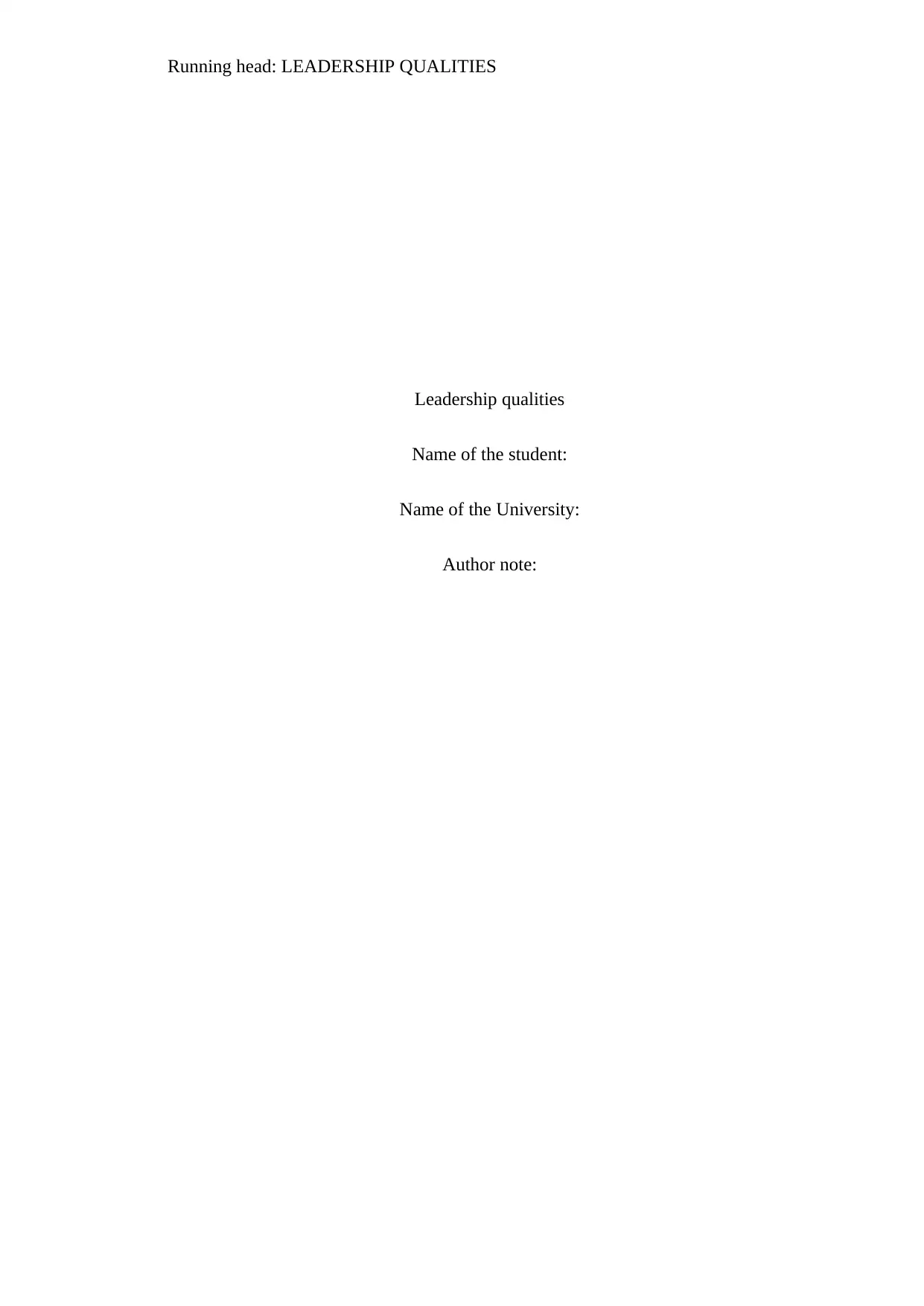
Running head: LEADERSHIP QUALITIES
Leadership qualities
Name of the student:
Name of the University:
Author note:
Leadership qualities
Name of the student:
Name of the University:
Author note:
Paraphrase This Document
Need a fresh take? Get an instant paraphrase of this document with our AI Paraphraser
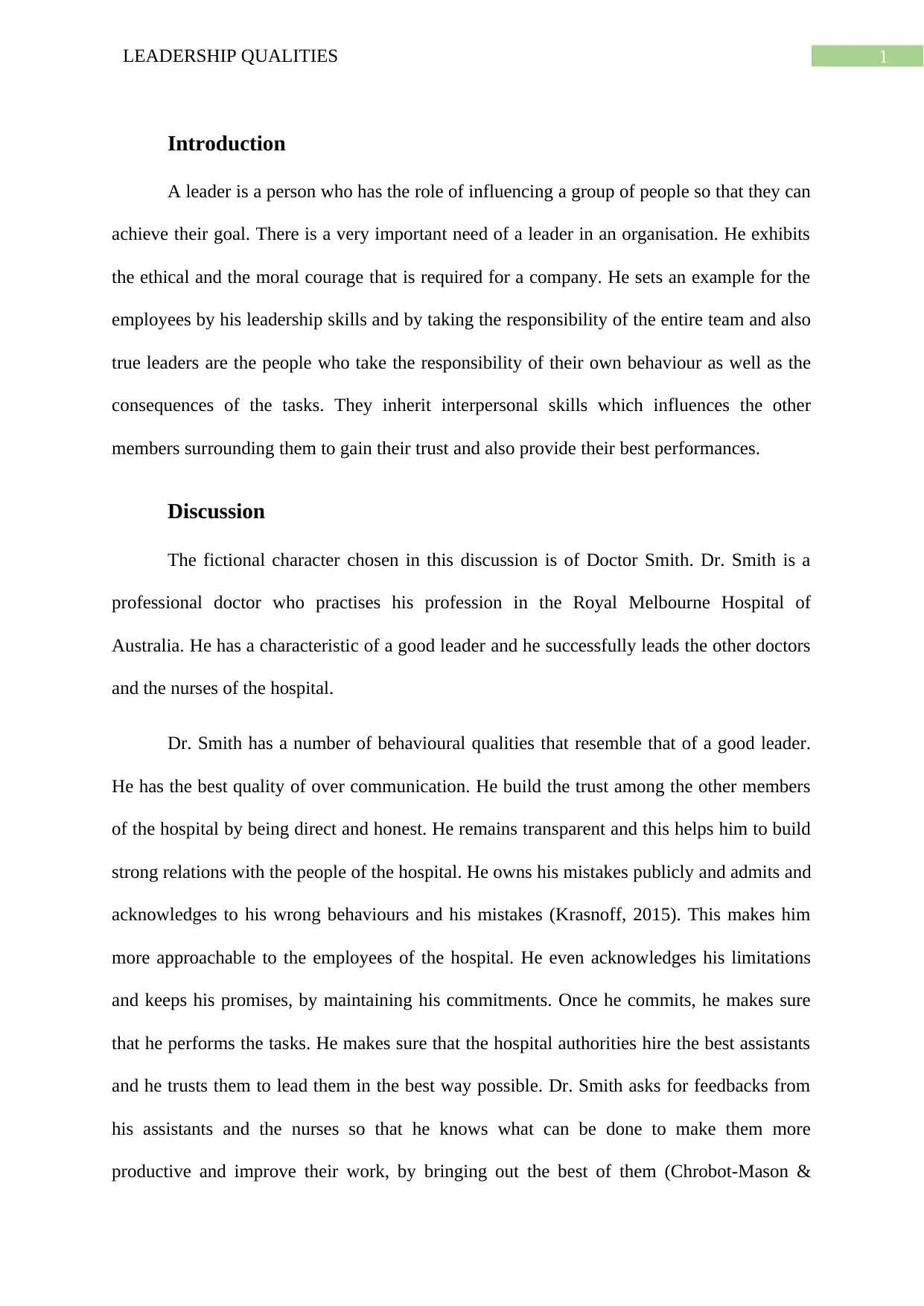
1LEADERSHIP QUALITIES
Introduction
A leader is a person who has the role of influencing a group of people so that they can
achieve their goal. There is a very important need of a leader in an organisation. He exhibits
the ethical and the moral courage that is required for a company. He sets an example for the
employees by his leadership skills and by taking the responsibility of the entire team and also
true leaders are the people who take the responsibility of their own behaviour as well as the
consequences of the tasks. They inherit interpersonal skills which influences the other
members surrounding them to gain their trust and also provide their best performances.
Discussion
The fictional character chosen in this discussion is of Doctor Smith. Dr. Smith is a
professional doctor who practises his profession in the Royal Melbourne Hospital of
Australia. He has a characteristic of a good leader and he successfully leads the other doctors
and the nurses of the hospital.
Dr. Smith has a number of behavioural qualities that resemble that of a good leader.
He has the best quality of over communication. He build the trust among the other members
of the hospital by being direct and honest. He remains transparent and this helps him to build
strong relations with the people of the hospital. He owns his mistakes publicly and admits and
acknowledges to his wrong behaviours and his mistakes (Krasnoff, 2015). This makes him
more approachable to the employees of the hospital. He even acknowledges his limitations
and keeps his promises, by maintaining his commitments. Once he commits, he makes sure
that he performs the tasks. He makes sure that the hospital authorities hire the best assistants
and he trusts them to lead them in the best way possible. Dr. Smith asks for feedbacks from
his assistants and the nurses so that he knows what can be done to make them more
productive and improve their work, by bringing out the best of them (Chrobot-Mason &
Introduction
A leader is a person who has the role of influencing a group of people so that they can
achieve their goal. There is a very important need of a leader in an organisation. He exhibits
the ethical and the moral courage that is required for a company. He sets an example for the
employees by his leadership skills and by taking the responsibility of the entire team and also
true leaders are the people who take the responsibility of their own behaviour as well as the
consequences of the tasks. They inherit interpersonal skills which influences the other
members surrounding them to gain their trust and also provide their best performances.
Discussion
The fictional character chosen in this discussion is of Doctor Smith. Dr. Smith is a
professional doctor who practises his profession in the Royal Melbourne Hospital of
Australia. He has a characteristic of a good leader and he successfully leads the other doctors
and the nurses of the hospital.
Dr. Smith has a number of behavioural qualities that resemble that of a good leader.
He has the best quality of over communication. He build the trust among the other members
of the hospital by being direct and honest. He remains transparent and this helps him to build
strong relations with the people of the hospital. He owns his mistakes publicly and admits and
acknowledges to his wrong behaviours and his mistakes (Krasnoff, 2015). This makes him
more approachable to the employees of the hospital. He even acknowledges his limitations
and keeps his promises, by maintaining his commitments. Once he commits, he makes sure
that he performs the tasks. He makes sure that the hospital authorities hire the best assistants
and he trusts them to lead them in the best way possible. Dr. Smith asks for feedbacks from
his assistants and the nurses so that he knows what can be done to make them more
productive and improve their work, by bringing out the best of them (Chrobot-Mason &
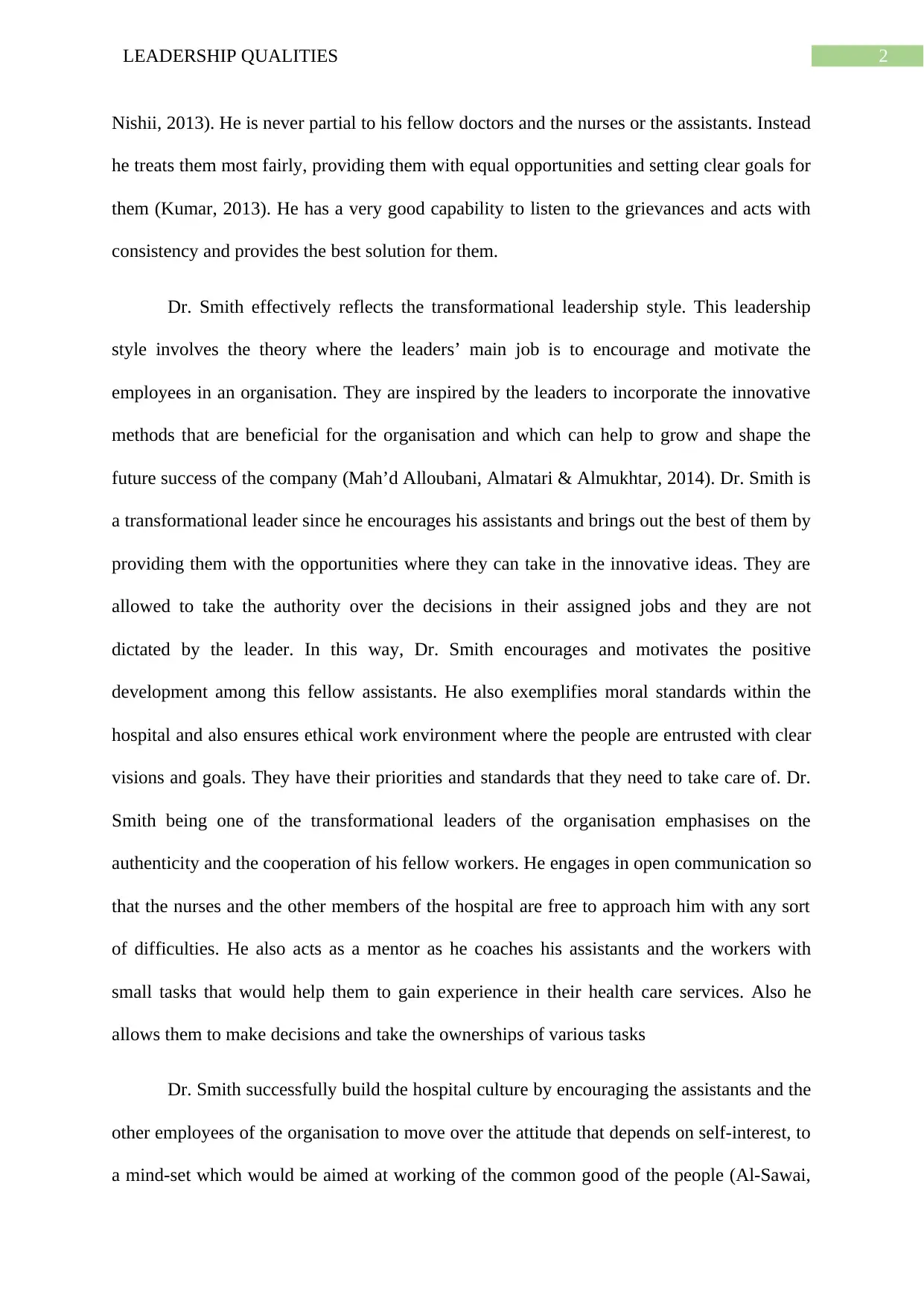
2LEADERSHIP QUALITIES
Nishii, 2013). He is never partial to his fellow doctors and the nurses or the assistants. Instead
he treats them most fairly, providing them with equal opportunities and setting clear goals for
them (Kumar, 2013). He has a very good capability to listen to the grievances and acts with
consistency and provides the best solution for them.
Dr. Smith effectively reflects the transformational leadership style. This leadership
style involves the theory where the leaders’ main job is to encourage and motivate the
employees in an organisation. They are inspired by the leaders to incorporate the innovative
methods that are beneficial for the organisation and which can help to grow and shape the
future success of the company (Mah’d Alloubani, Almatari & Almukhtar, 2014). Dr. Smith is
a transformational leader since he encourages his assistants and brings out the best of them by
providing them with the opportunities where they can take in the innovative ideas. They are
allowed to take the authority over the decisions in their assigned jobs and they are not
dictated by the leader. In this way, Dr. Smith encourages and motivates the positive
development among this fellow assistants. He also exemplifies moral standards within the
hospital and also ensures ethical work environment where the people are entrusted with clear
visions and goals. They have their priorities and standards that they need to take care of. Dr.
Smith being one of the transformational leaders of the organisation emphasises on the
authenticity and the cooperation of his fellow workers. He engages in open communication so
that the nurses and the other members of the hospital are free to approach him with any sort
of difficulties. He also acts as a mentor as he coaches his assistants and the workers with
small tasks that would help them to gain experience in their health care services. Also he
allows them to make decisions and take the ownerships of various tasks
Dr. Smith successfully build the hospital culture by encouraging the assistants and the
other employees of the organisation to move over the attitude that depends on self-interest, to
a mind-set which would be aimed at working of the common good of the people (Al-Sawai,
Nishii, 2013). He is never partial to his fellow doctors and the nurses or the assistants. Instead
he treats them most fairly, providing them with equal opportunities and setting clear goals for
them (Kumar, 2013). He has a very good capability to listen to the grievances and acts with
consistency and provides the best solution for them.
Dr. Smith effectively reflects the transformational leadership style. This leadership
style involves the theory where the leaders’ main job is to encourage and motivate the
employees in an organisation. They are inspired by the leaders to incorporate the innovative
methods that are beneficial for the organisation and which can help to grow and shape the
future success of the company (Mah’d Alloubani, Almatari & Almukhtar, 2014). Dr. Smith is
a transformational leader since he encourages his assistants and brings out the best of them by
providing them with the opportunities where they can take in the innovative ideas. They are
allowed to take the authority over the decisions in their assigned jobs and they are not
dictated by the leader. In this way, Dr. Smith encourages and motivates the positive
development among this fellow assistants. He also exemplifies moral standards within the
hospital and also ensures ethical work environment where the people are entrusted with clear
visions and goals. They have their priorities and standards that they need to take care of. Dr.
Smith being one of the transformational leaders of the organisation emphasises on the
authenticity and the cooperation of his fellow workers. He engages in open communication so
that the nurses and the other members of the hospital are free to approach him with any sort
of difficulties. He also acts as a mentor as he coaches his assistants and the workers with
small tasks that would help them to gain experience in their health care services. Also he
allows them to make decisions and take the ownerships of various tasks
Dr. Smith successfully build the hospital culture by encouraging the assistants and the
other employees of the organisation to move over the attitude that depends on self-interest, to
a mind-set which would be aimed at working of the common good of the people (Al-Sawai,
⊘ This is a preview!⊘
Do you want full access?
Subscribe today to unlock all pages.

Trusted by 1+ million students worldwide
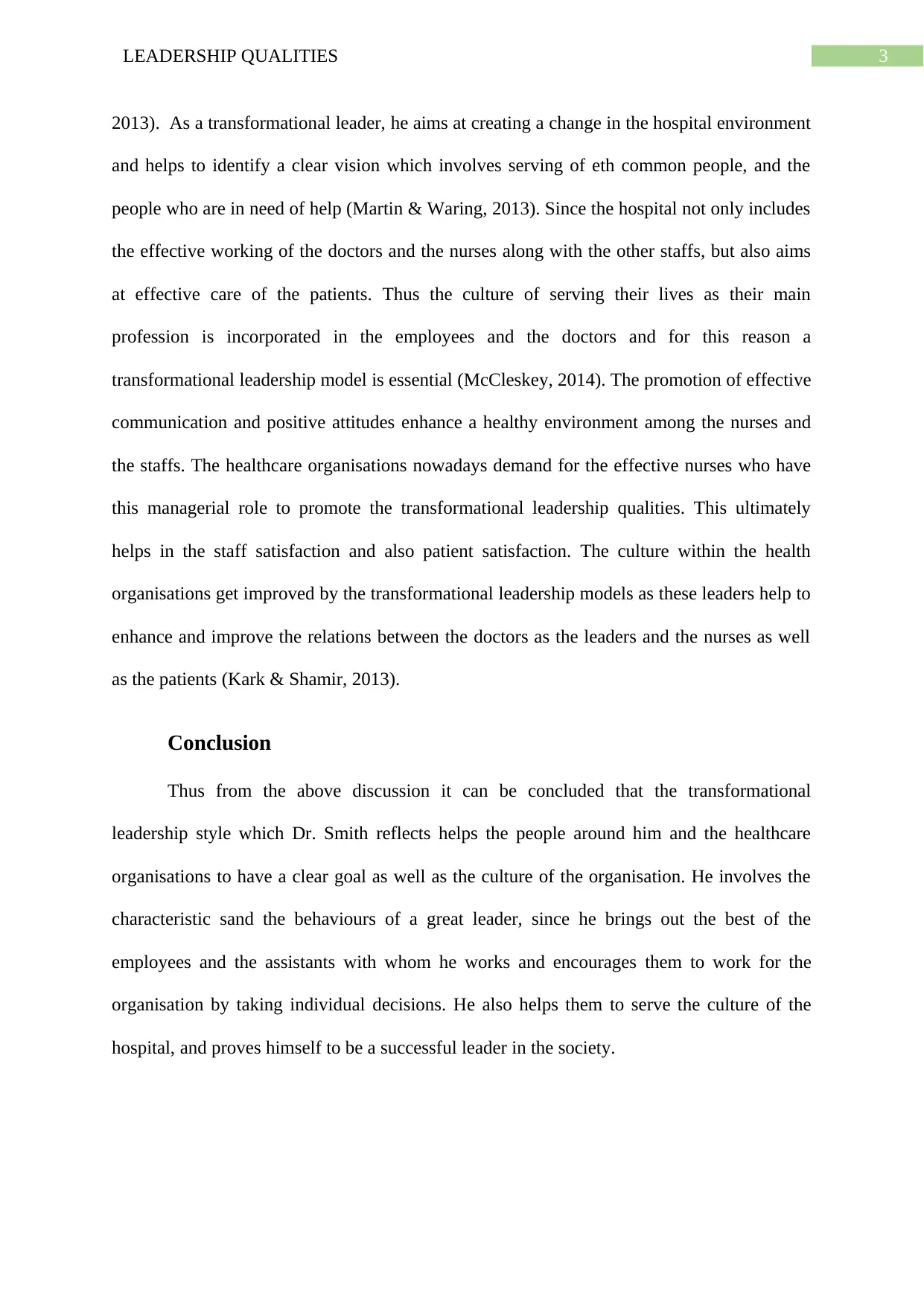
3LEADERSHIP QUALITIES
2013). As a transformational leader, he aims at creating a change in the hospital environment
and helps to identify a clear vision which involves serving of eth common people, and the
people who are in need of help (Martin & Waring, 2013). Since the hospital not only includes
the effective working of the doctors and the nurses along with the other staffs, but also aims
at effective care of the patients. Thus the culture of serving their lives as their main
profession is incorporated in the employees and the doctors and for this reason a
transformational leadership model is essential (McCleskey, 2014). The promotion of effective
communication and positive attitudes enhance a healthy environment among the nurses and
the staffs. The healthcare organisations nowadays demand for the effective nurses who have
this managerial role to promote the transformational leadership qualities. This ultimately
helps in the staff satisfaction and also patient satisfaction. The culture within the health
organisations get improved by the transformational leadership models as these leaders help to
enhance and improve the relations between the doctors as the leaders and the nurses as well
as the patients (Kark & Shamir, 2013).
Conclusion
Thus from the above discussion it can be concluded that the transformational
leadership style which Dr. Smith reflects helps the people around him and the healthcare
organisations to have a clear goal as well as the culture of the organisation. He involves the
characteristic sand the behaviours of a great leader, since he brings out the best of the
employees and the assistants with whom he works and encourages them to work for the
organisation by taking individual decisions. He also helps them to serve the culture of the
hospital, and proves himself to be a successful leader in the society.
2013). As a transformational leader, he aims at creating a change in the hospital environment
and helps to identify a clear vision which involves serving of eth common people, and the
people who are in need of help (Martin & Waring, 2013). Since the hospital not only includes
the effective working of the doctors and the nurses along with the other staffs, but also aims
at effective care of the patients. Thus the culture of serving their lives as their main
profession is incorporated in the employees and the doctors and for this reason a
transformational leadership model is essential (McCleskey, 2014). The promotion of effective
communication and positive attitudes enhance a healthy environment among the nurses and
the staffs. The healthcare organisations nowadays demand for the effective nurses who have
this managerial role to promote the transformational leadership qualities. This ultimately
helps in the staff satisfaction and also patient satisfaction. The culture within the health
organisations get improved by the transformational leadership models as these leaders help to
enhance and improve the relations between the doctors as the leaders and the nurses as well
as the patients (Kark & Shamir, 2013).
Conclusion
Thus from the above discussion it can be concluded that the transformational
leadership style which Dr. Smith reflects helps the people around him and the healthcare
organisations to have a clear goal as well as the culture of the organisation. He involves the
characteristic sand the behaviours of a great leader, since he brings out the best of the
employees and the assistants with whom he works and encourages them to work for the
organisation by taking individual decisions. He also helps them to serve the culture of the
hospital, and proves himself to be a successful leader in the society.
Paraphrase This Document
Need a fresh take? Get an instant paraphrase of this document with our AI Paraphraser
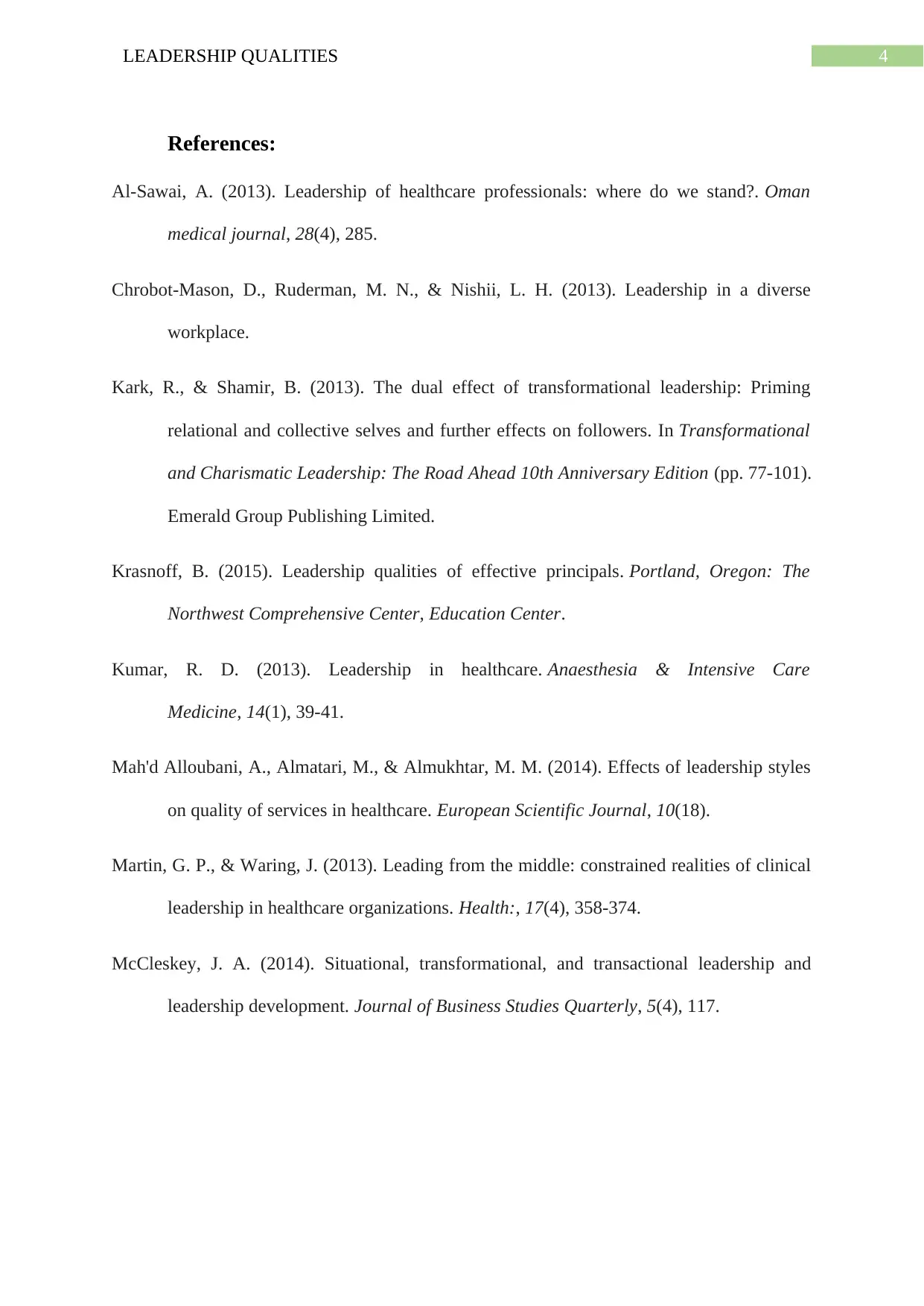
4LEADERSHIP QUALITIES
References:
Al-Sawai, A. (2013). Leadership of healthcare professionals: where do we stand?. Oman
medical journal, 28(4), 285.
Chrobot-Mason, D., Ruderman, M. N., & Nishii, L. H. (2013). Leadership in a diverse
workplace.
Kark, R., & Shamir, B. (2013). The dual effect of transformational leadership: Priming
relational and collective selves and further effects on followers. In Transformational
and Charismatic Leadership: The Road Ahead 10th Anniversary Edition (pp. 77-101).
Emerald Group Publishing Limited.
Krasnoff, B. (2015). Leadership qualities of effective principals. Portland, Oregon: The
Northwest Comprehensive Center, Education Center.
Kumar, R. D. (2013). Leadership in healthcare. Anaesthesia & Intensive Care
Medicine, 14(1), 39-41.
Mah'd Alloubani, A., Almatari, M., & Almukhtar, M. M. (2014). Effects of leadership styles
on quality of services in healthcare. European Scientific Journal, 10(18).
Martin, G. P., & Waring, J. (2013). Leading from the middle: constrained realities of clinical
leadership in healthcare organizations. Health:, 17(4), 358-374.
McCleskey, J. A. (2014). Situational, transformational, and transactional leadership and
leadership development. Journal of Business Studies Quarterly, 5(4), 117.
References:
Al-Sawai, A. (2013). Leadership of healthcare professionals: where do we stand?. Oman
medical journal, 28(4), 285.
Chrobot-Mason, D., Ruderman, M. N., & Nishii, L. H. (2013). Leadership in a diverse
workplace.
Kark, R., & Shamir, B. (2013). The dual effect of transformational leadership: Priming
relational and collective selves and further effects on followers. In Transformational
and Charismatic Leadership: The Road Ahead 10th Anniversary Edition (pp. 77-101).
Emerald Group Publishing Limited.
Krasnoff, B. (2015). Leadership qualities of effective principals. Portland, Oregon: The
Northwest Comprehensive Center, Education Center.
Kumar, R. D. (2013). Leadership in healthcare. Anaesthesia & Intensive Care
Medicine, 14(1), 39-41.
Mah'd Alloubani, A., Almatari, M., & Almukhtar, M. M. (2014). Effects of leadership styles
on quality of services in healthcare. European Scientific Journal, 10(18).
Martin, G. P., & Waring, J. (2013). Leading from the middle: constrained realities of clinical
leadership in healthcare organizations. Health:, 17(4), 358-374.
McCleskey, J. A. (2014). Situational, transformational, and transactional leadership and
leadership development. Journal of Business Studies Quarterly, 5(4), 117.

5LEADERSHIP QUALITIES
⊘ This is a preview!⊘
Do you want full access?
Subscribe today to unlock all pages.

Trusted by 1+ million students worldwide
1 out of 6
Related Documents
Your All-in-One AI-Powered Toolkit for Academic Success.
+13062052269
info@desklib.com
Available 24*7 on WhatsApp / Email
![[object Object]](/_next/static/media/star-bottom.7253800d.svg)
Unlock your academic potential
Copyright © 2020–2025 A2Z Services. All Rights Reserved. Developed and managed by ZUCOL.





